Maintaining your vehicle involves several key aspects, and among the most crucial for safety is ensuring clear visibility through your windshield. Regularly replacing your wiper blades is a fundamental part of this maintenance. To simplify your choice, our automotive experts have rigorously tested and selected the best wiper blades available, guaranteeing optimal performance and longevity.
We’ve encountered torrential downpours and sudden storms that emphasize the critical role of effective wiper blades in maintaining control on the road. For consistent, high-performance in diverse conditions, we recommend the Rain-X Silicone Endura as our top overall pick. These blades combine silicone technology with a robust design for extended durability. However, for drivers in drier climates, the AERO Voyager J-Hook offers an excellent balance of affordability and quality, featuring a premium beam-style design at a budget-friendly price.
While wiper blades may seem like a straightforward car accessory, subtle differences in design and materials significantly impact their effectiveness. We’ve thoroughly examined these nuances to distinguish superior options from subpar ones. This guide breaks down the essential factors, from traditional to beam-style blades and rubber to silicone materials, highlighting the top performers based on our extensive testing in the demanding conditions of the Pacific Northwest.
Editor’s Note: Our guide to the best wiper blades was last updated on March 19, 2025, to include the AERO Voyager J-Hook as our new best budget choice and the Anco Winter Wiper as a top recommendation for winter driving.
Top Wiper Blades of 2025
Best Overall Wiper Blades
Rain-X Silicone Endura
Rating: 9.1 / 10
Key Features:
- Wiper Style: Beam
- Blade Material: Silicone
- Available Lengths: 14-28 inches
- Attachment Types: J-hook, pinch tab, pinch tab button, pin arm, side pin
Pros:
- Premium silicone blade with graphite coating for extended lifespan compared to rubber.
- Enhanced pivot point design increases pressure against the windshield for better contact.
- Silicone blade applies a water-repellent treatment with each use.
- Secure locking clasp for stable attachment.
Cons:
- More expensive than many rubber wiper blade options.
- Less widely stocked than Rain-X’s Advantedge Premium line.
Expert Review:
The Rain-X Silicone Endura ($26) stands out as a leading choice among windshield wipers due to its exceptional combination of a robust beam structure, silicone blade technology, and integrated water-repelling capabilities. In our tests, these blades consistently delivered long-lasting performance, impressing us with their streak-free cleaning and quiet operation.
Silicone wiper blades offer significant advantages over traditional rubber squeegees. They resist degradation from UV exposure, ozone, and temperature extremes, ensuring a longer service life. Furthermore, the gradual silicone deposition creates a Rain-X-like effect on your windshield, causing water to bead and roll away effortlessly, enhancing visibility in wet conditions.
Compared to other models we evaluated, the Silicone Endura blades produced minimal streaking and operated with remarkable quietness, even at high speeds. Many silicone blades improve with use as silicone builds up on the windshield, and these are no exception. Running the wipers dry for a few cycles can help accelerate this bedding-in process, quickly establishing the water-beading effect.
The mounting system of the Silicone Endura is robust and elevates the pivot point, which increases the clamping force on the windshield, ensuring consistent contact. While the J-hook attachment initially feels a bit tricky to release, the process becomes straightforward once you learn the technique: pivot the blade perpendicular to the arm, then press the release tab. The addition of a locking clasp provides extra security against detachment.
In a direct comparison with our premium pick, the PIAA Si-Techs, we observed virtually no discernible differences, even noting matching serial numbers. This strongly suggests these wipers are essentially identical, making the Enduras an even more appealing option given their typically lower price point, often around $10 less per blade. For most drivers seeking top-tier performance, the Silicone Endura wiper blades are an excellent and cost-effective choice.
Best Budget Wiper Blades
AERO Voyager J-Hook
Check Price at Walmart $17 at Amazon
Rating: 6.1 / 10
Key Features:
- Wiper Style: Beam
- Blade Material: Rubber
- Available Lengths: 13-28 inches
- Attachment Types: Small and large J-hook
Pros:
- Very affordable, especially as they are sold in sets of two.
- DuPont Teflon coating enhances wiping performance and reduces friction.
- Backed by a 1-year warranty, demonstrating manufacturer confidence.
- Includes an extra set of rubber wiper elements, doubling the lifespan.
- Aerodynamic design with a wiper arm cover for reduced wind lift and noise.
Cons:
- Limited to J-hook attachment style, which may not fit all vehicles.
- Rubber blades are less effective at water removal compared to silicone and can squeak when dry.
Expert Review:
Previously, we often recommended traditional branch-style wipers for budget-conscious buyers. However, after testing the AERO Voyager J-Hook Wiper Blades ($17), we’ve been thoroughly impressed. These modern beam wipers offer superior design and performance, often at half the price of our previous budget recommendations.
Priced at just $17 for a pair, the AERO Voyagers are incredibly economical. Considering their price point, it’s almost practical to buy two sets, keeping a spare for future replacement. Adding to their value, each set includes replacement rubber wiper elements and a 1-year warranty, making them an unbeatable deal. A notable feature is the inclusion of replaceable squeegees, a rarity in wiper blades, which enhances their environmental friendliness by reducing waste.
During our tests, both stationary and on-road, the rubber wiper elements of the Voyager blades didn’t quite match the water-clearing efficiency of silicone blades. However, the Teflon coating significantly minimizes the squeaking commonly associated with untreated rubber wipers.
The 1-year warranty sets these wiper blades apart from most competitors, including our top pick which only offers a 90-day warranty. This extended warranty provides added peace of mind. We’ve been using them for six months without any issues, confirming their reliability.
The main trade-off for the budget price is the mounting system, which is exclusively compatible with J-hook wiper arms. If your vehicle requires a different attachment style for budget wiper blades, the Trico Flex blades are a comparable alternative. Otherwise, the AERO Voyagers represent the best value on the market for wiper blades, combining performance and affordability effectively.
Best Branch-Style Wiper Blades
SilBlade Standard
Rating: 6.8 / 10
Key Features:
- Wiper Style: Branch
- Blade Material: Silicone
- Available Lengths: 11-28 inches
- Attachment Types: J-hook, pin arm
Pros:
- Silicone wiper blades at a competitive price point.
- Wide range of available lengths to fit various vehicles.
- Robust powder-coated steel frame, more durable than typical branch wipers.
Cons:
- Mounting hardware is not as robust, with limited attachment options.
- Branch-style design is less effective in snowy conditions compared to beam designs.
Expert Review:
Choosing branch-style wiper blades usually means compromising on blade material, often settling for cheaper rubber squeegees. However, the SilBlade Standard ($26) breaks this mold. These wipers are ideal for drivers in drier regions who may not require the enhanced performance of beam-style wipers but still desire quality. They offer an economical solution without sacrificing the benefits of silicone wiper technology.
In our wiper blade testing, the SilBlades performed around the middle of the pack, showing minimal streaking and noise. We did notice a slight shudder at the end of each stroke, but it was minor and not distracting during normal driving. For everyday use, their performance is more than adequate.
The SilBlades are available in a broad spectrum of lengths (11-28 inches), fitting a wide array of vehicles. However, attachment options are limited to the most common J-hook and pin arm types. Installation on our test truck was straightforward, though owners of European vehicles might encounter compatibility issues.
For those seeking a more contemporary design, SilBlade also offers beam-style FlexBlade and hybrid UniBlade options. The silicone SilBlade Standards are a sensible choice for drivers who want to avoid both premium prices and bargain-bin quality, providing a solid balance of performance and value.
Best Beam-Style Wiper Blades
Bosch Icon
$26 at Amazon Check price at Tire Rack
Rating: 8.9 / 10
Key Features:
- Wiper Style: Beam
- Blade Material: Rubber
- Available Lengths: 13-28 inches
- Attachment Types: J-hook, side-lock, pinch-tab, top-lock
Pros:
- Premium beam design offers exceptional flexibility and windshield contact.
- Easiest wiper blades to install, featuring a user-friendly locking clasp.
- Excellent choice for cold weather driving where silicone blades may become brittle.
Cons:
- Traditional rubber blades do not perform as effectively as silicone across all weather conditions.
- Fewer attachment options compared to some competitors.
Expert Review:
The Bosch Icon ($30) wiper blades have earned their strong reputation, and our tests confirm they are well-deserved. These beam-style wipers represent the pinnacle of beam blade design, featuring a smooth flex pattern and an aggressive curvature that ensures consistent contact with your windshield.
While we generally favor silicone wiper blades for superior performance, the rubber compound used in the Bosch Icons is certainly high-quality and effective. In our tests, these wipers cleared water efficiently and exhibited even less streaking than the Rain-X Latitudes. The primary drawback of rubber is in long-term durability compared to silicone, but this is not due to any compromise in build quality.
Installation of the Bosch Icons was the easiest among all the wiper blades we tested for this guide. They feature a simple locking clasp that secures the blade in one motion. Removal is equally effortless, a welcome contrast to many other wipers that often require more effort and can pinch fingers.
In particularly cold and icy climates, silicone wiper blades can become too soft and may tear if used to clear ice buildup on an unscraped windshield. For drivers in such environments, a robust rubber wiper like the Bosch Icon is a more practical choice, offering durability and reliable performance in harsh winter conditions.
Best Premium Wiper Blades
PIAA Si-Tech
$36 at Amazon Check price at Tire Rack
Rating: 9.2 / 10
Key Features:
- Wiper Style: Beam
- Blade Material: Silicone
- Available Lengths: 14-28 inches
- Attachment Types: J-hook, push-button arm, side-pin, bayonet, pin & hook
Pros:
- High-performance beam design paired with silicone wiper blades for optimal cleaning.
- Includes windshield prep wipes to enhance the silicone water-repellent treatment.
- Wiper refills are available from PIAA, extending the life of the wiper assembly.
- Backed by a 1-year limited warranty, demonstrating product quality and durability.
Cons:
- Lacks a locking clasp, which some users prefer for added security.
- More expensive than most other wiper blade options.
Expert Review:
As previously noted, the PIAA Si-Tech ($36) windshield wipers are remarkably similar to the Rain-X Silicone Enduras, with only minor distinctions. Whether these differences justify the price premium is subjective, but they do position the Si-Tech as our top premium wiper blade choice.
One key differentiator is that the Si-Tech wipers include a windshield preparation pack, consisting of an alcohol cleaner and liquid silicone. This kit enhances the silicone wiper blade’s water-repelling capabilities, taking the concept to a higher level. While similar results can be achieved by separately applying a commercial water-repellent treatment like Rain-X, the inclusion of the prep pack with the Si-Tech wipers provides added convenience and elevates their out-of-the-box performance.
Another advantage is that PIAA offers silicone wiper refills specifically for the Si-Tech model, unlike Rain-X for the Enduras. This refill option allows users to replace only the worn wiper blades, extending the life of the wiper assembly and potentially saving money in the long run.
The beam design of the PIAA Si-Tech is on par with the best from Rain-X and Bosch in terms of water removal efficiency. It ensures full blade contact and minimal streaking. Noise levels were also among the lowest we recorded. Even as the initial windshield treatment wears off, the silicone blades continue to deposit a water-repellent layer, maintaining excellent water beading over time.
Although you can achieve comparable performance for less with the Rain-X Silicone Endura, the extra features and convenience of the Si-Tech, especially the included prep kit and refill availability, make them the top choice for those prioritizing turn-key, premium performance in wiper blades.
Best Winter Wiper Blades
Anco Winter Wiper
Rating: 7.0 / 10
Key Features:
- Wiper Style: Branch
- Blade Material: Rubber
- Available Lengths: 11-24 inches
- Attachment Types: J-hook, side pin, small and large bayonet styles
Pros:
- Full rubber cover encloses the wiper blade, protecting it from snow and ice buildup.
- Rubber wiper elements are less prone to tearing in extremely low temperatures compared to silicone.
- Affordable price point makes them a practical seasonal choice.
Cons:
- Wiping performance is not as refined as premium all-season blades.
- Wiper arm mount design is not the most robust, potentially affecting durability.
Expert Review:
Winter conditions can be particularly harsh on wiper blades. While high-performance silicone beam blades like the Bosch Icons perform admirably, they can also suffer damage in severe winter weather. Therefore, we recommend switching to dedicated winter wiper blades, much like changing to snow tires. The Anco Winter Wiper Blades ($25) are our top recommendation for winter use.
These wipers are designed for functionality over aesthetics, prioritizing durability in harsh conditions. Their key winter-ready feature is a thick rubber sleeve that fully encases the blade, preventing snow and ice accumulation. After a season of use in the snowy North Cascades, they proved their effectiveness.
The wiper blades themselves are made of rubber, which, while not our preferred material for optimal water clearing in all conditions, is more resistant to tearing when dragged across icy windshields—a common winter scenario. We found their performance adequate for typical Pacific Northwest winters, especially when paired with a Rain-X treatment to enhance water repellency. Note that the Anco wipers themselves are not pre-treated, so applying a windshield treatment is beneficial for maximizing their winter performance.
The connection system is user-friendly and compatible with hook, side-pin, and small/large bayonet-style wiper arms. We easily installed them on our Honda CRV test vehicle at the start of winter and swapped them back to our standard wipers in the spring.
An added benefit of using seasonal wiper blades is that it extends the lifespan of your summer blades. The Anco Winter blades are our recommended choice for a reliable and affordable set of winter wipers, offering essential protection and performance during the colder months.
Other Recommended Wiper Blades
The wiper blades detailed above are our primary recommendations, based on extensive testing and year-round use on our own vehicles. They have proven dependable even in severe weather. However, many other excellent options are available. Consider these alternatives before making your final decision.
Trico Silicone Ceramic
$27 at Amazon Check price at Tire Rack
Rating: 7.1 / 10
Key Features:
- Wiper Style: Beam
- Blade Material: Silicone
- Available Lengths: 14-28 inches
- Attachment Types: J-hook, push button, side-pin, pinch-tab
Pros:
- Highly aerodynamic design with integrated spoiler.
- Silicone wiper blades feature a ceramic coating to minimize friction and enhance durability.
- Provides excellent contact across the entire windshield for consistent cleaning.
Cons:
- Among the more expensive wiper blade options on the market.
- Broad attachment base may slightly limit flexibility across the entire wiper length.
Expert Review:
The Trico Silicone Ceramic ($36) wiper blades are positioned at the higher end of the price spectrum but offer significant value for the investment. Their premium cost reflects advanced materials and engineering, particularly the ceramic coating on the silicone blades designed to ensure smooth, long-lasting performance.
Wiping performance is comparable to top-tier models like the PIAA Si-Tech and Rain-X Silicone Endura. The ceramic coating is expected to significantly extend the lifespan of these blades by reducing friction and wear. A major cause of wiper blade noise and inefficiency is debris on the windshield. The smooth glide provided by the ceramic coating helps these blades maintain performance even when encountering dirt and grime, contributing to their longevity.
These wipers boast the most aerodynamic design in our tests, featuring an integrated spoiler that aids in maintaining consistent windshield contact, especially at higher speeds. While the aerodynamic benefits might not generate noticeable downforce, the enhanced contact is undeniable, eliminating high-speed shuddering.
Choosing between the Trico Silicone Ceramic and PIAA Si-Tech is a close call. We slightly lean towards the PIAA due to its more aggressive curvature and the included water-repellent wipes. However, in terms of long-term performance and durability, the Silicone Ceramics are a strong contender, making it difficult to definitively choose between these two premium options.
Rain-X Latitude Water Repellency
Rating: 7.3 / 10
Key Features:
- Wiper Style: Beam
- Blade Material: Rubber
- Available Lengths: 14-28 inches
- Attachment Types: J-hooks, pinch-tab, pin-arms, pinch-tab button
Pros:
- Silicone Rain-X coating on rubber blades enhances smooth operation and water repellency.
- Well-curved beam design ensures good windshield contact.
- Quiet operation, even at higher wiper speeds.
Cons:
- Bulkier attachment mount compared to sleeker designs.
- Rain-X treatment is temporary and can feel greasy if touched directly.
Expert Review:
The Rain-X Latitude Water Repellency ($18) wiper blades occupy a solid mid-range position in terms of both price and performance. They offer effective water clearing, a durable beam design, and a Rain-X silicone coating that promotes smooth, consistent wiping action. For a rubber wiper blade, the Latitude offers excellent overall performance.
As a rubber blade, the Latitude integrates a silicone treatment to mimic some of the benefits of silicone blades. This coating is applied to the blades and transferred to the windshield during initial use, providing a water-repellent effect. While not as long-lasting as a dedicated wipe-on treatment or full silicone blades, it is effective and we observed water beading after just a few wipes in our tests. In terms of longevity, we found the treatment lasted through a full summer and fall season of regular use in the Pacific Northwest.
The beam design is similar to the Rain-X Silicone Endura but features a slightly more aggressive curve, which helped maintain contact with the windshield during high-speed testing. The attachment mount is somewhat bulky, which might slightly increase wind resistance compared to more streamlined designs.
Often available for around $18 per blade, the Latitude Water Repellency blades are a compelling budget-friendly option. Enhancing their water-beading performance with Rain-X Washer Fluid Additive can further extend their effectiveness throughout the year, offering a cost-effective alternative to fully silicone wiper blades.
Trico Flex
Rating: 6.9 / 10
Key Features:
- Wiper Style: Beam
- Blade Material: Rubber
- Available Lengths: 13-32 inches
- Attachment Types: J-hook, pinch-tab, side-pin, push-button, side-lock, bayonet
Pros:
- Very budget-friendly pricing.
- Durable beam design for consistent windshield contact.
- Wide range of available lengths to fit many vehicles.
Cons:
- Showed slight streaking in our performance tests.
- Plastic frame feels less robust and has a less aggressive curvature compared to premium models.
Expert Review:
A strong contender for our best budget wiper blades, the Trico Flex ($17) offers significant value at a low price. While they use a more economical rubber wiper insert, the blade design of the Flex wipers is surprisingly effective, providing excellent water removal in our tests with only minor streaking.
Performance-wise, the Trico Flex blades compare favorably to the Bosch Icons, with the primary advantage of the Icons being their superior attachment mechanism. Despite this, the performance of the Flex wipers was commendable, leaving little room for complaint given their price.
In hand, the Trico Flex blades do feel slightly less premium in construction compared to higher-end options. The plastic frame and mount have a somewhat lighter-duty feel. Attachment compatibility is also slightly less extensive, so owners of vehicles with less common wiper attachments may need to explore other options.
As an excellent budget choice, the Flex wiper blades deliver dependable performance across various testing metrics without excelling in any single area. For drivers who don’t require top-of-the-line performance or live in regions with infrequent rainfall, these wipers are a practical and cost-effective solution to keep your windshield clear.
Tested and proven, we put these wipers through rigorous washer fluid tests.
Wiper Blade Comparison Chart
| Wiper Blades | Price (Per Wiper) | Wiper Style | Blade Material | Available Lengths |
|---|---|---|---|---|
| Rain-X Silicone Endura | $26 | Beam | Silicone | 14-28 inches |
| AERO Voyager J-Hook | $8 | Beam | Rubber | 13-28 inches |
| SilBlade Standard | $26 | Branch | Silicone | 11-28 inches |
| Bosch Icon | $30 | Beam | Rubber | 13-28 inches |
| PIAA Si-Tech | $36 | Beam | Silicone | 14-28 inches |
| Anco Winter Wiper | $25 | Branch | Rubber | 11-24 inches |
| Trico Silicone Ceramic | $36 | Beam | Silicone | 14-28 inches |
| Rain-X Latitude Water Repellency | $18 | Beam | Rubber | 14-28 inches |
| Trico Flex | $17 | Beam | Rubber | 13-32 inches |
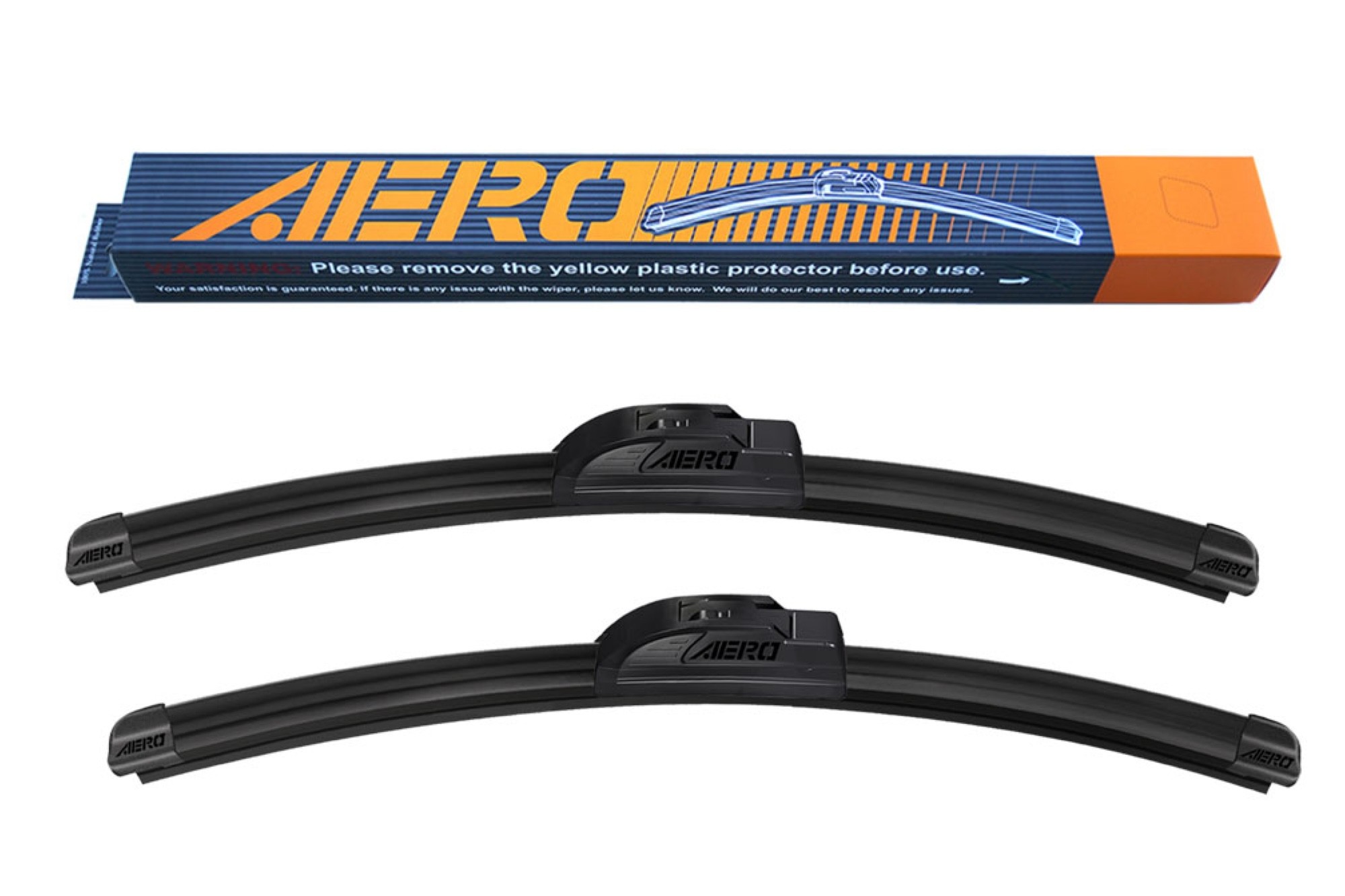

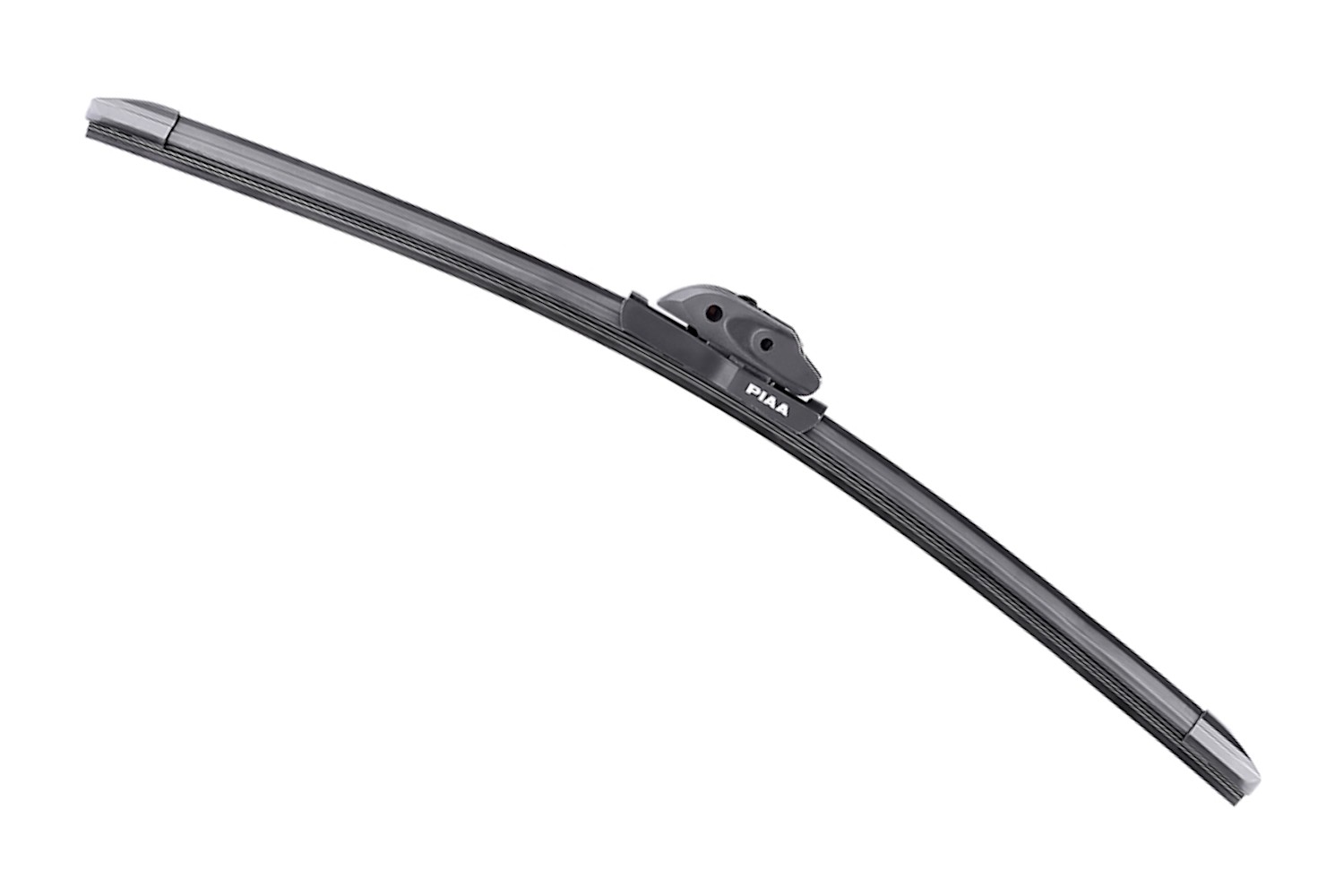
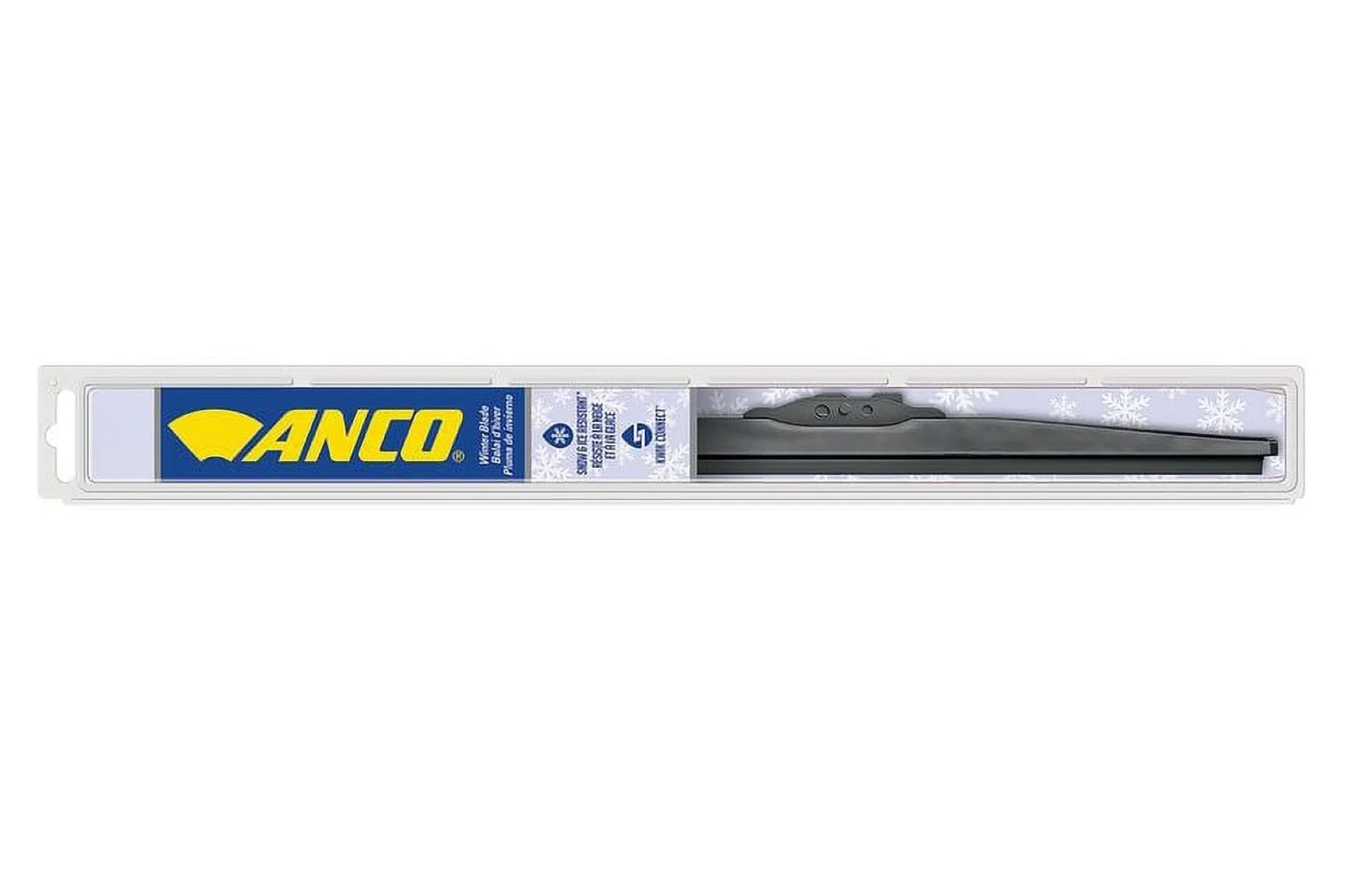

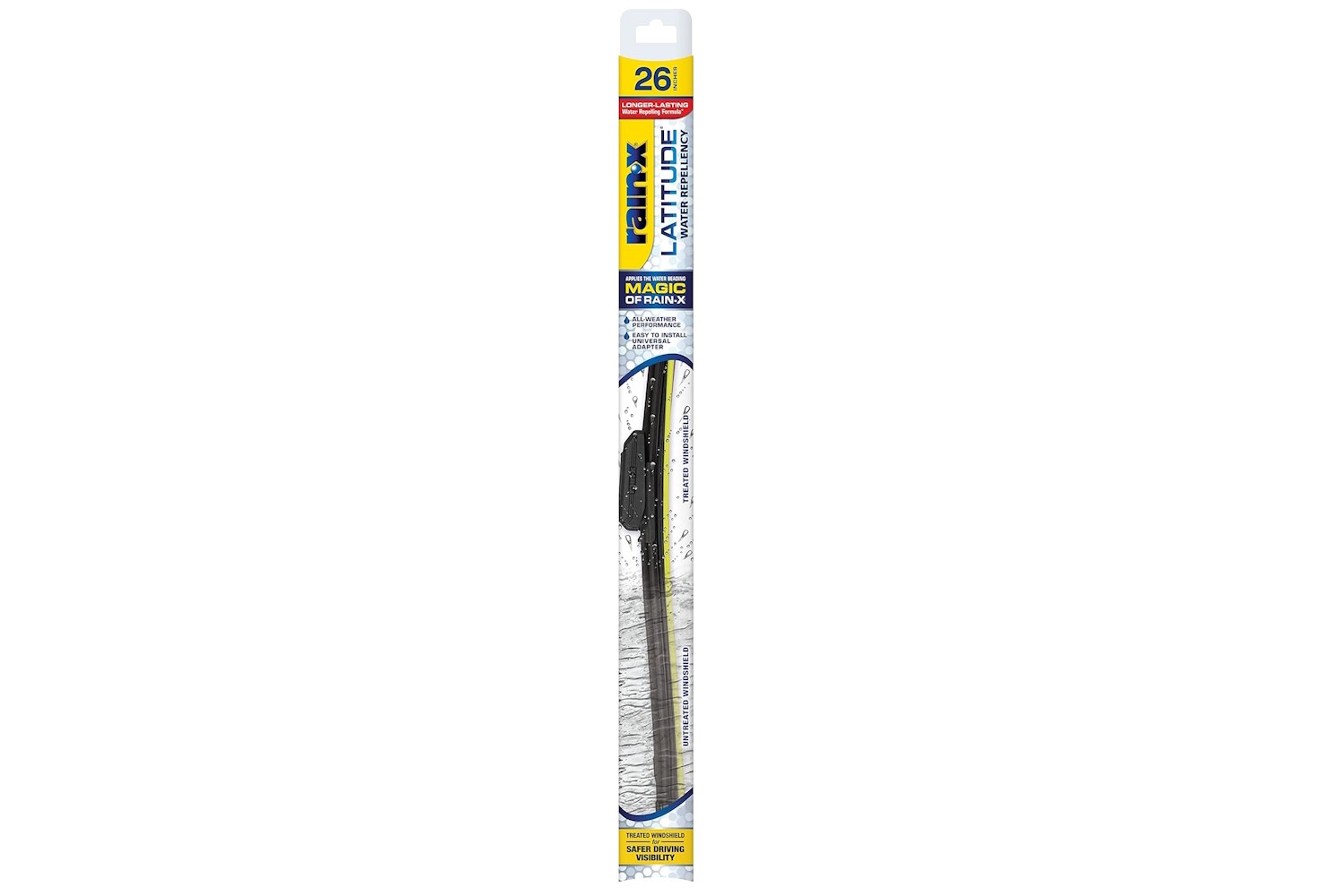
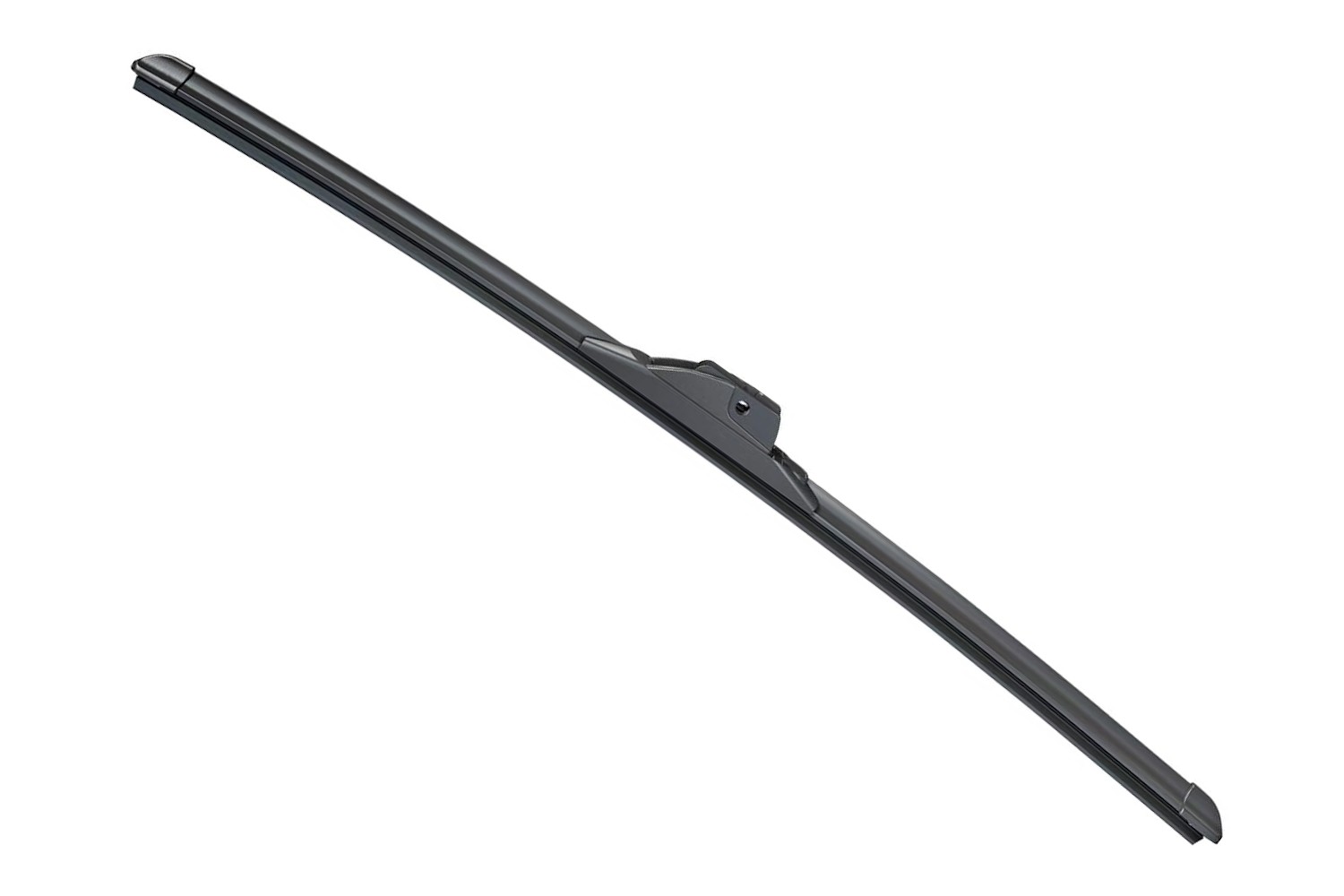
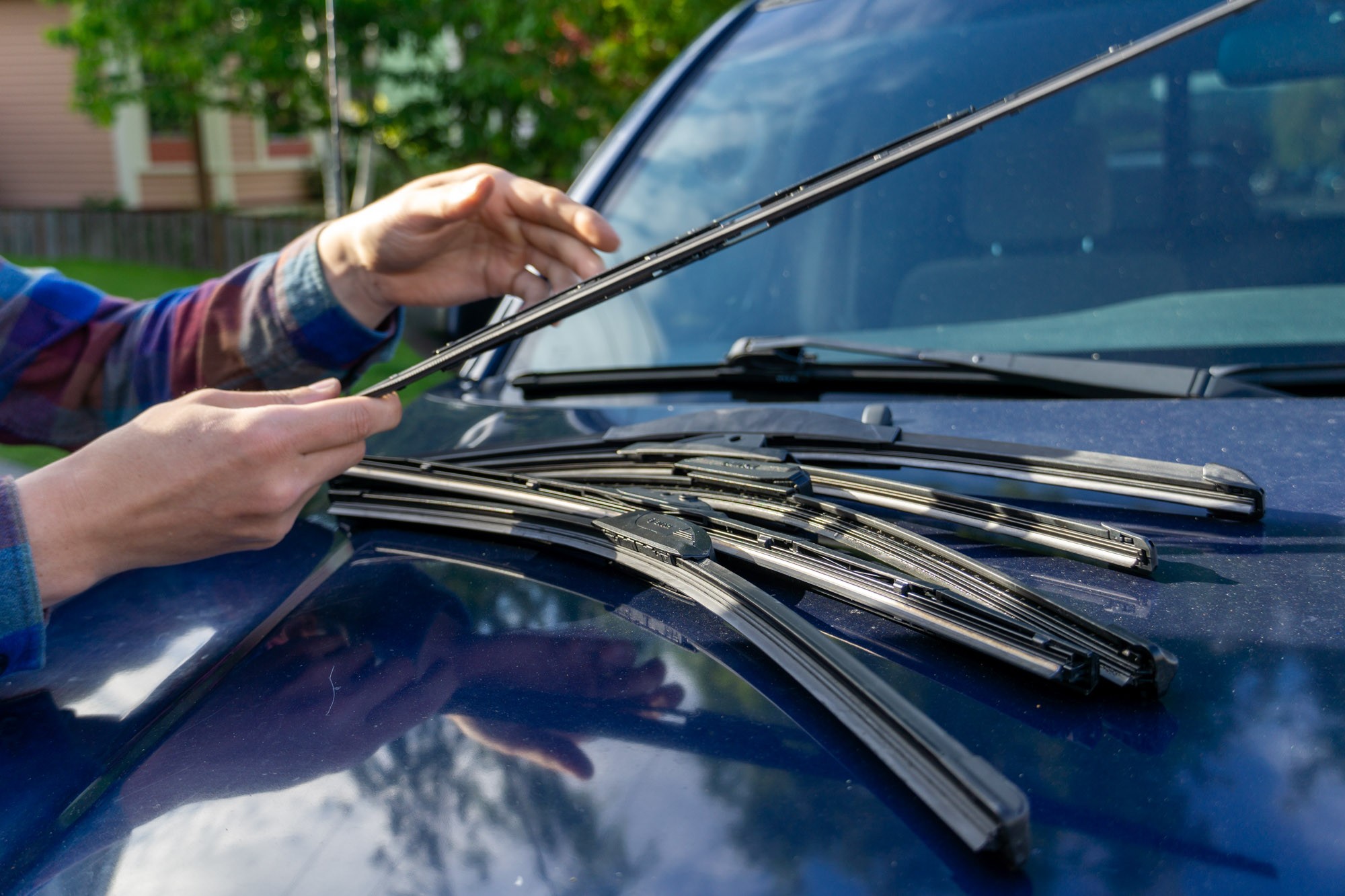
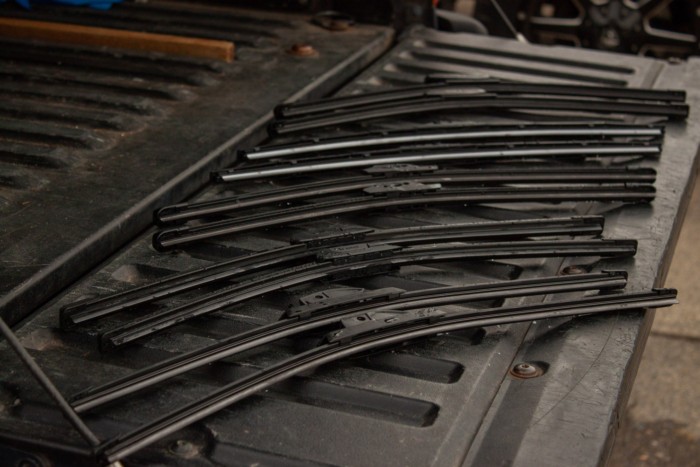

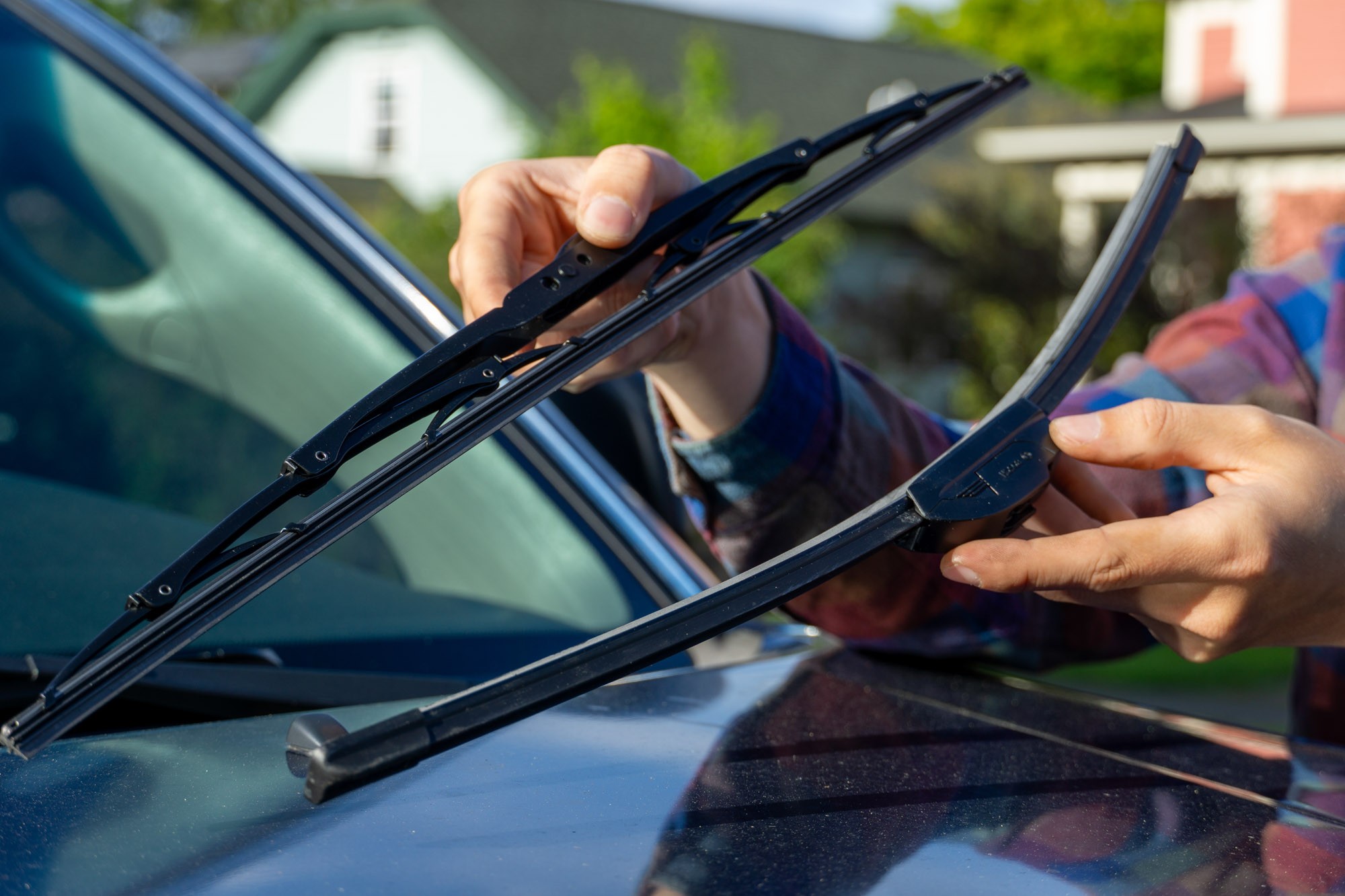
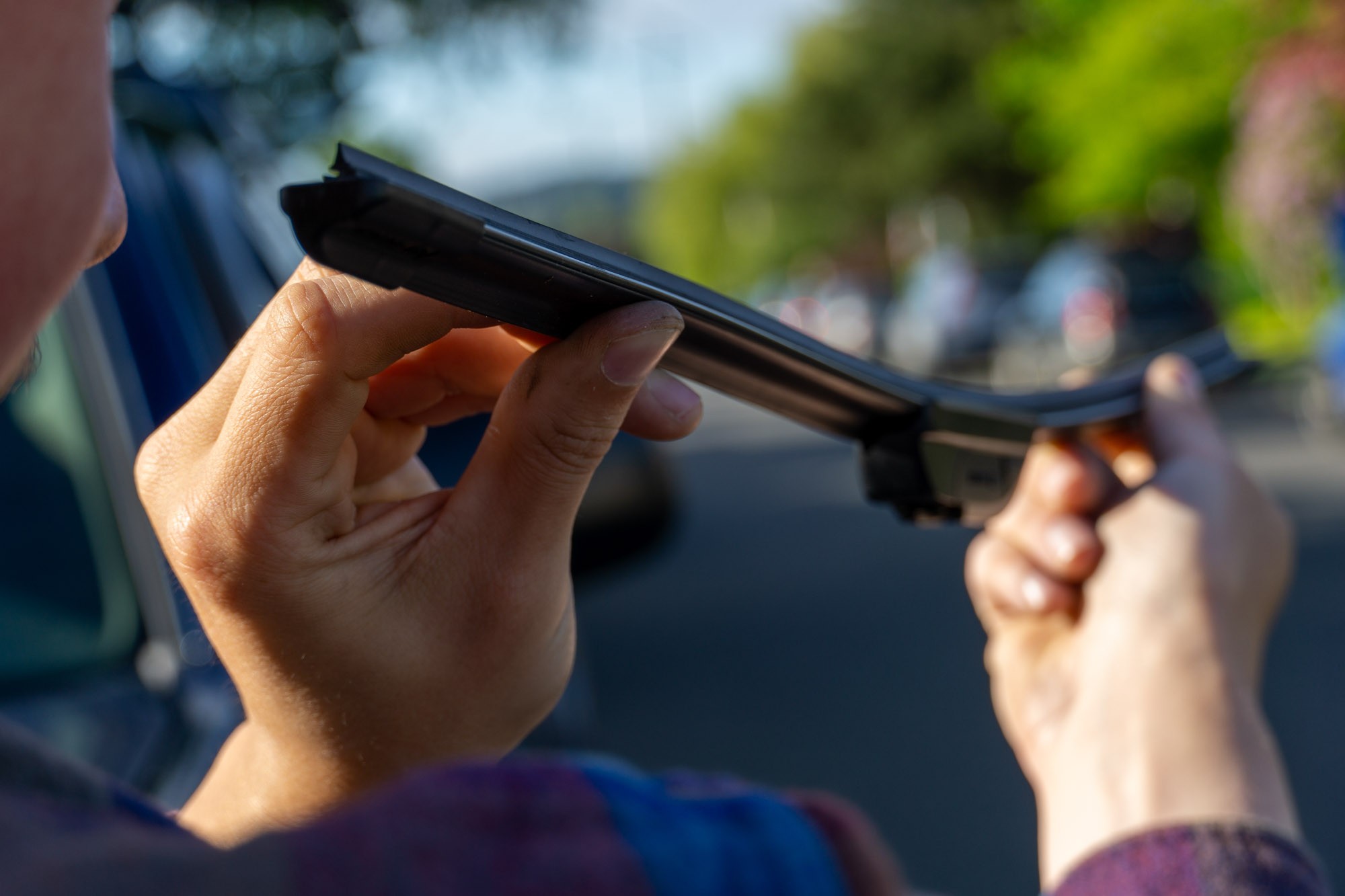
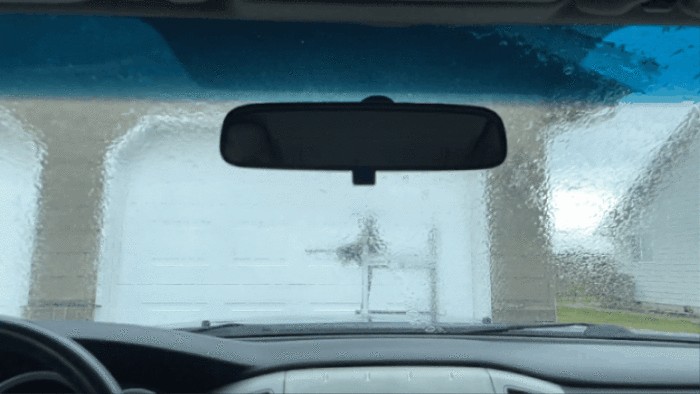

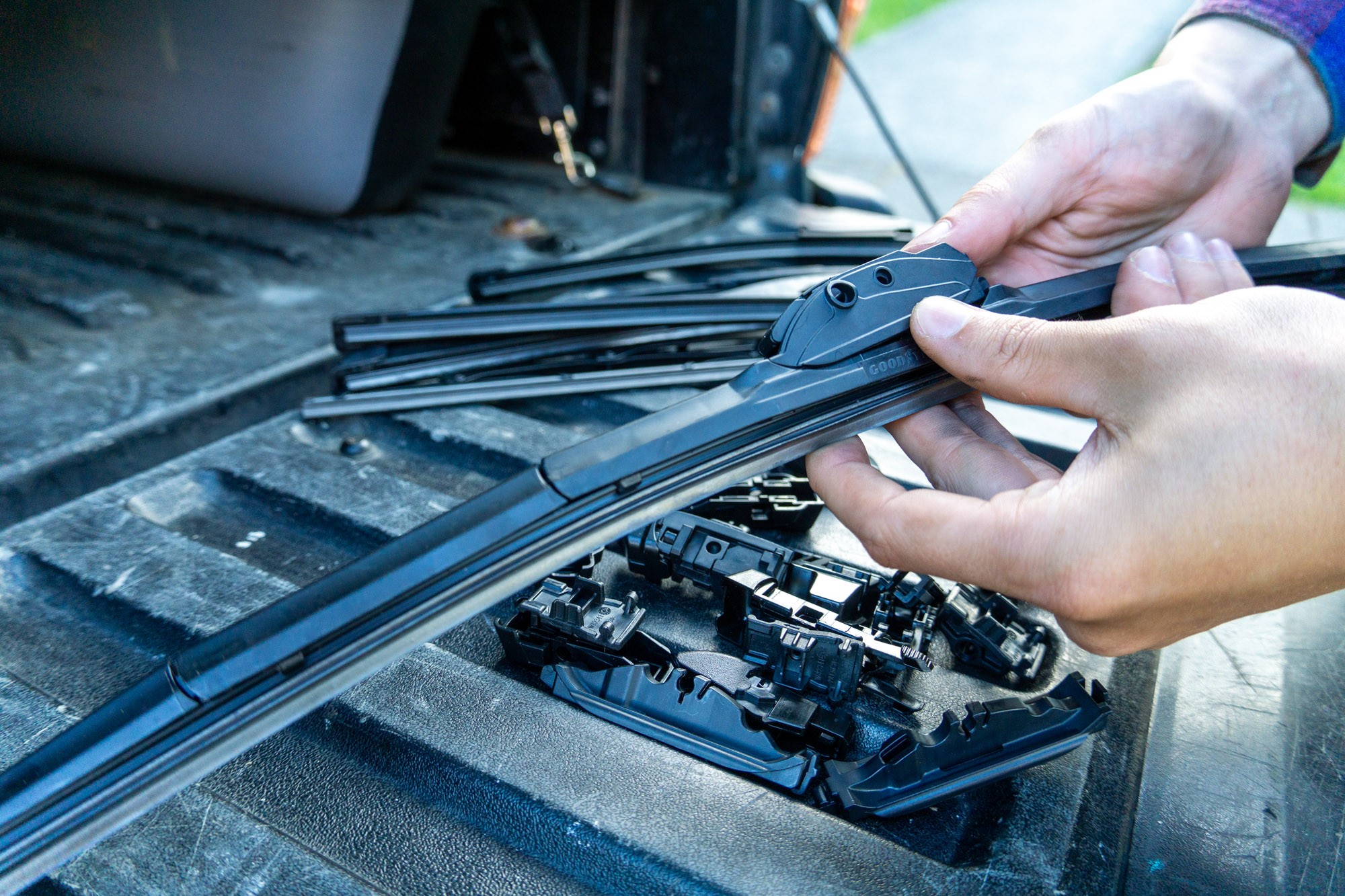
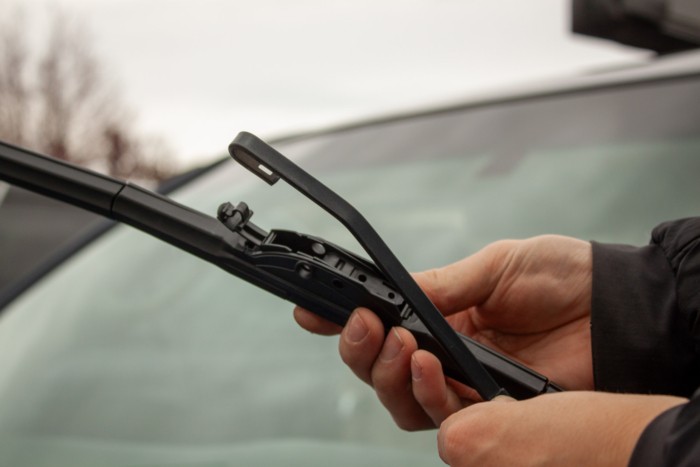
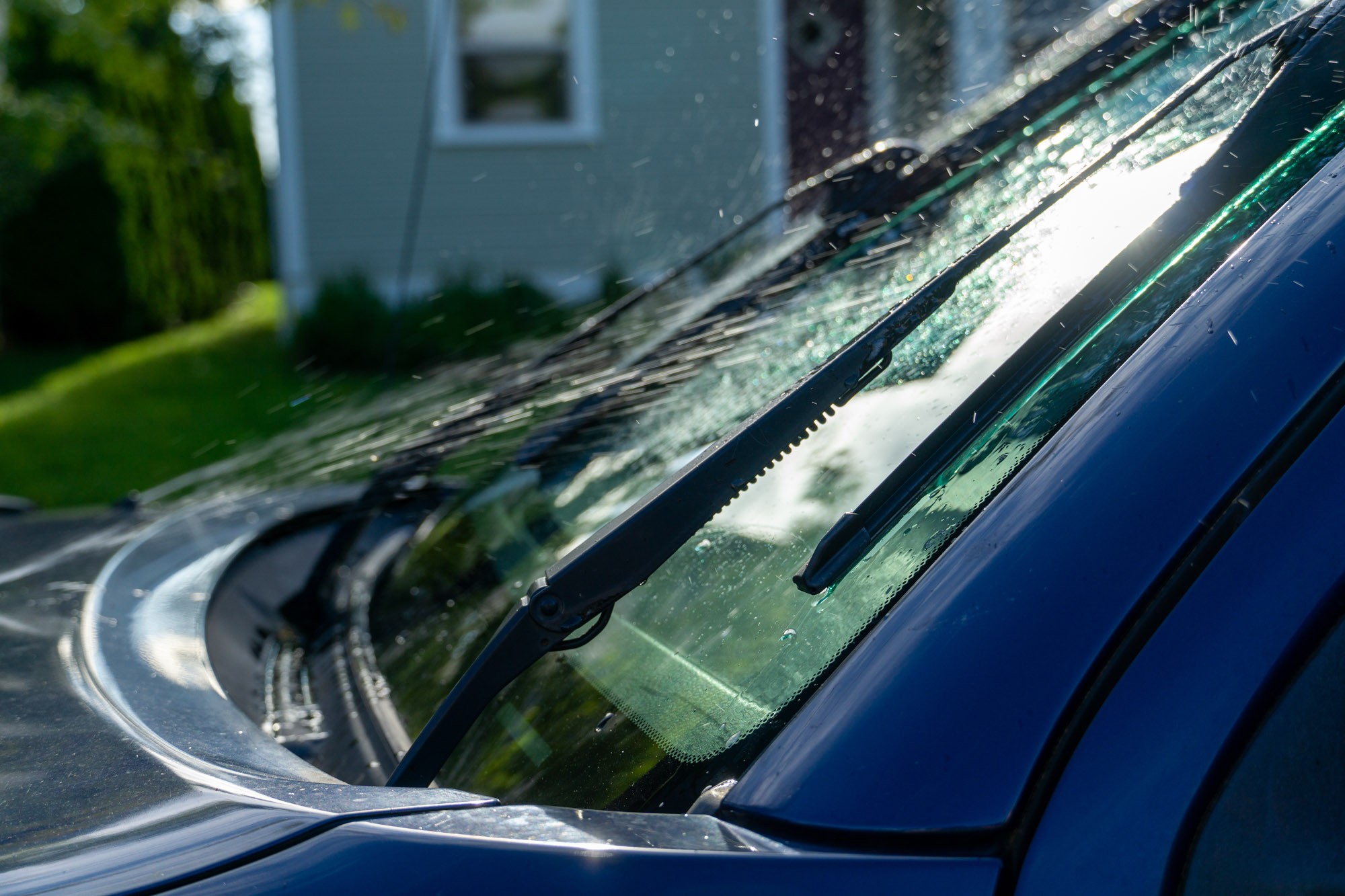
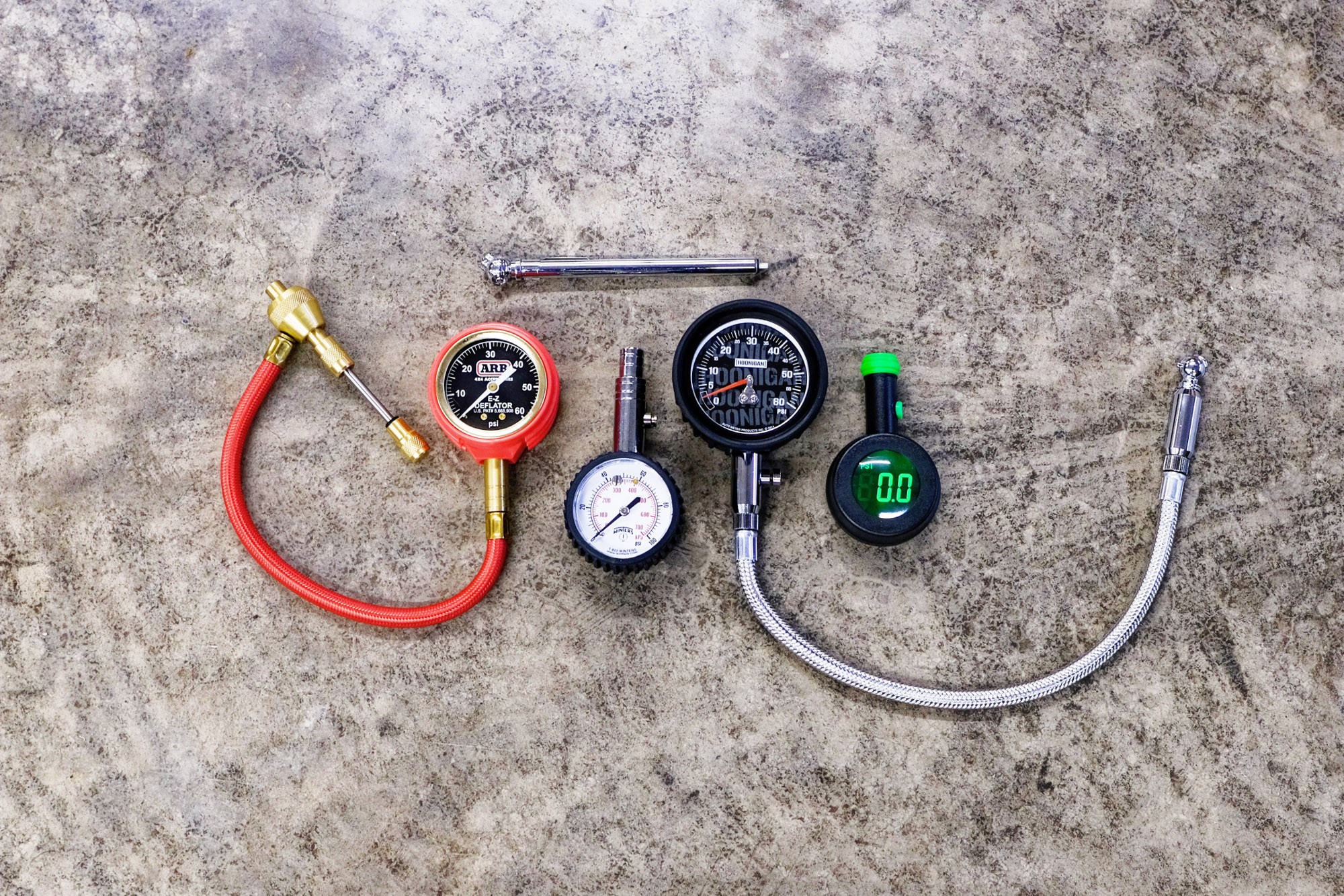
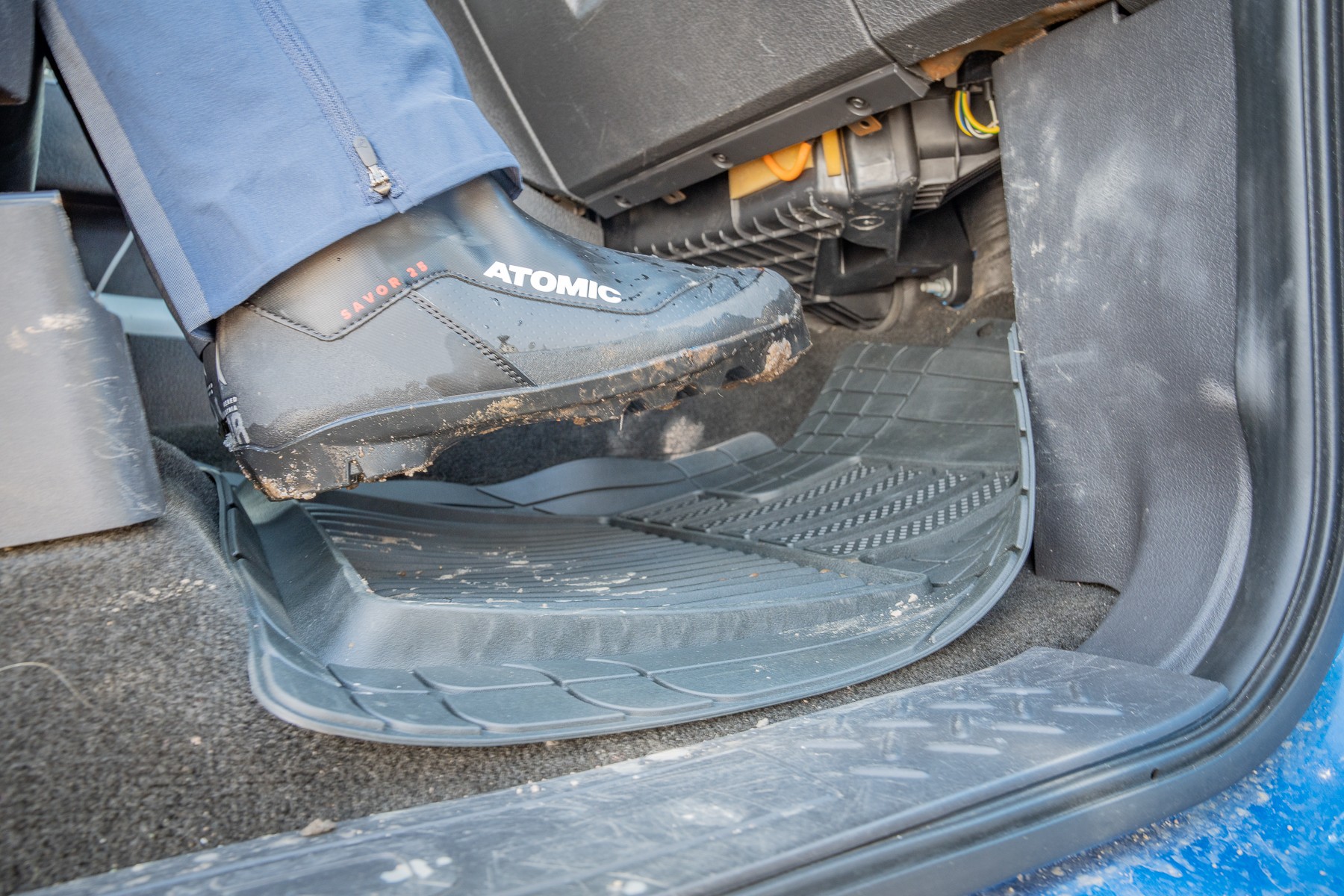
How We Tested the Best Wiper Blades
After countless wiper blade swaps, we’ve developed expert fingertips and a deep understanding of what makes a great set.
It would be simple to recommend just any wiper blade—as is often the case at auto parts counters—but we committed to a rigorous testing process to truly differentiate the best from the rest. Our approach involved thorough research, both online and through discussions with our experienced road-warrior staff about their preferred wiper blades. Our final selection aims to cover a wide range of needs and preferences, ensuring there’s an excellent option for every driver.
Our Testing Methodology and Environment
We adopted a scientific approach to wiper blade testing to eliminate marketing biases and gather reliable, repeatable data. Our setup included our trusty Toyota Tacoma, carefully positioned sprinklers, a slow-motion camera, and an audio recorder.
Each wiper blade was tested under identical conditions: same water volume and wiper speed. We recorded each test to objectively compare water removal efficiency and noise levels. For blades requiring a silicone wipe-on treatment, we meticulously cleaned the windshield between tests to ensure a consistent and unbiased testing surface.
We also carefully assessed the installation and removal process for each set (becoming quite proficient in both). Wiper blades often use various adapters for different vehicle mounts. We challenged multiple testers to install each set without consulting instructions. Through some trial and error (and a few pinched fingers), we gained a practical understanding of the installation complexity for each wiper blade.
Beyond controlled stationary tests, we conducted real-world driving tests in diverse conditions. This included driving through heavy rain on the Olympic Peninsula, snowstorms in British Columbia, and muddy trails en route to campsites. Frequent blade changes during these trips provided ample opportunity to evaluate ease of installation and removal and to assess on-road performance.
Finally, we continuously monitor the durability and longevity of these wiper blades through extended use on our personal vehicles, tracking their performance until failure. Our reviews are regularly updated with this long-term data, and we consistently test new wiper blades as they become available to keep our recommendations current and comprehensive.
Our Expert Testers
Based north of Seattle, famously known as the Rainy City, our lead tester Nick Belcaster experiences significant annual rainfall, necessitating frequent wiper blade replacements and even leading to wiper motor replacements due to overuse. His travels across the West have placed him in numerous mountain passes at inopportune moments, giving him ample reason to both appreciate and curse his wiper blades, depending on their condition.
Our wiper blade evaluations are further enhanced by input from a broad team of GearJunkie editors and contributors with extensive automotive knowledge, who provide testing feedback based on their experiences with various vehicles and driving conditions.
Buyer’s Guide: Choosing the Right Wiper Blades
The first rule of wiper blades: replace them before you actually need them.
While often an afterthought during routine car maintenance like oil changes, wiper blades are critically important for driving safety. While improvisations like a passenger furiously wiping the windshield might be humorous in a pinch, reliable wiper blades are essential. Just as important as maintaining clear headlights, proper tire inflation, or addressing engine error codes, regular wiper blade maintenance is a key factor in ensuring vehicle safety and longevity.
Our testing revealed that modern wiper blades incorporate considerable technology. Factors like blade design, material composition, and coatings significantly influence performance and lifespan. Consider these aspects when selecting your next set of wiper blades to ensure you get the best value and performance for your money.
Wiper Blade Design
Branch-style wipers are traditional and reliable, while beam-style blades offer superior overall performance.
Windshield wiper blade technology has evolved significantly since their invention in 1903 by Mary Anderson. Key advancements include frame design, which impacts how effectively wipers clear your windshield.
Traditional Branch Frames
Branch-frame wipers have been a standard in vehicles for decades. Their design is relatively simple, accommodating the curvature of modern windshields, but they offer less consistent pressure distribution across the blade. Typically constructed from painted or powder-coated steel, these frames can degrade and rust over time with heavy use.
In snowy or icy conditions, branch-style wipers are prone to ice buildup within the frame structure, leading to chattering and reduced cleaning efficiency. For drivers in drier climates, branch wipers like the SilBlade Standards or PIAA Super Silicones can be a cost-effective choice. Due to their adequate but not exceptional performance, we typically use branch-style wipers for rear windshields where demands are less critical.
Beam Frames
The curvature of beam blades ensures consistent contact across the entire windshield surface.
Modern beam-frame wiper blades represent a significant advancement in wiper technology. They typically feature a one- or two-piece design with integrated metal bands that apply even pressure along the entire length of the blade. This uniform pressure distribution results in superior performance compared to branch-style wipers, characterized by less chatter and fewer missed spots.
Beam-style wipers also maintain tighter contact with the windshield, enhancing aerodynamics and reducing wind noise and lift, particularly at higher speeds. In our testing, the Bosch Icons exemplify perfected beam blade design, offering excellent flexibility and consistent contact across the windshield.
Hybrid Frames
Hybrid frame designs combine elements of both branch and beam styles. They incorporate a branch frame structure with an aerodynamic cover, which minimizes wind lift and keeps the wiper firmly pressed against the windshield. This hybrid approach also helps mitigate ice buildup issues common with traditional branch frames, offering a blend of durability and improved performance.
Performance
Watching water being cleared isn’t thrilling, but it provided valuable data for our tests.
Quantifying wiper blade performance requires a detailed approach. To rigorously evaluate and compare different wiper blades, we developed a quasi-scientific testing method. Using a garden hose and ladder, we simulated typical Pacific Northwest rain conditions, from light sprinkles to heavy downpours, and meticulously recorded our observations to analyze later.
The primary wipe stroke—the initial pass across the windshield—is crucial for clearing the majority of the water. During this stroke, we assessed for smoothness of motion, absence of shuddering or streaking, and recorded audio to compare noise levels. We noted that lesser-performing blades often exhibited issues, particularly at the blade ends, where streaking and incomplete clearing were most common.
Between wipes, during the pause, we evaluated how effectively each blade cleared water by observing windshield clarity before the next spray. Our general observation was that beam-style wipers provided superior contact across the entire windshield surface, resulting in more uniform water removal compared to branch-style frames.
Silicone wipers also demonstrated a noticeable advantage. After just a few cycles, silicone started transferring to the windshield, enhancing water beading and shedding. This improved water repellency between wipes allowed for effective clearing even at lower wiper speeds, contributing to better overall visibility.
Wiper Blade Materials
The material of your wiper blade significantly impacts water clearing and durability.
The wiper blade material is where performance meets the windshield. These thin strips of rubber or silicone are precisely shaped to a fine edge, conforming to the windshield’s curvature to effectively squeegee water away.
Rubber Blades
Natural rubber has been the predominant material for wiper blades for many years. It provides effective wiping when properly maintained. However, dirty windshields are a primary cause of reduced wiper performance and can damage rubber blades, leading to premature wear and ineffective cleaning.
Rubber blades have a limited lifespan as they are susceptible to degradation from UV radiation, atmospheric ozone, and extreme temperatures. These environmental factors cause rubber to harden, crack, and lose its flexibility, reducing wiping efficiency over time.
Silicone Blades
Silicone wiper blades, though often more expensive, offer several advantages over rubber. They exhibit superior resistance to environmental degradation, including UV rays, ozone, and temperature fluctuations, resulting in a longer lifespan. Additionally, silicone blades deposit a microscopic layer of silicone onto the windshield with each use, creating a water-repellent surface that enhances visibility in rain and snow.
Wiper blades like the Rain-X Silicone Endura or PIAA Si-Tech outperformed rubber wipers in our tests. Their performance often improves with continued use as the silicone layer on the windshield builds up, further enhancing water beading and clearing efficiency.
Coated Blades
Both rubber and silicone wiper blades can be enhanced with coatings to reduce friction and improve performance. Common coatings include Teflon and graphite. These treatments, while not permanent, improve wiping smoothness and reduce wear, extending blade life.
The graphite coating on Rain-X Latitudes contributes to their quiet operation, while the ceramic coating on Trico Silicone Ceramics is a high-tech layer designed to minimize friction and ensure smoother, more effective wiping.
Automotive manufacturers use various wiper attachment types, requiring adaptable mounting systems.
Wiper Blade Mounting
While J-hook is the most common wiper arm attachment type, various other styles are used in modern vehicles, including side pins, bayonets, and push-button mounts.
To accommodate diverse vehicle applications, wiper blades often include multiple adapters within a single mounting system. Given the complexity of wiper attachments, it’s advisable to consult an auto parts store or online resources to confirm compatibility with your specific vehicle before purchase.
“Exact fit” wiper blades are also available, designed to meet the original equipment (OE) specifications for specific vehicle models. These blades come without adapters, simplifying installation as they are engineered to fit only designated vehicles, ensuring a direct and secure fit.
The J-hook is a widely used wiper arm attachment, but many other types exist.
Durability and Replacement Timing
Even the best wiper blades will eventually need replacing. Investing in durable, high-quality blades can extend replacement intervals significantly. Make wiper blade checks part of your regular vehicle maintenance checklist to ensure they are not overlooked.
Most wiper blades begin to show performance degradation around the 6-month mark, with many needing replacement after a year. However, premium wiper blades can often last for two years or more with minimal performance loss.
Beam-style wiper blades tend to be more durable due to fewer moving parts and a design less prone to debris and ice accumulation. Silicone blades also outlast rubber counterparts due to their more stable composition, resisting environmental wear and tear more effectively.
Using a water-repellent treatment like Rain-X can substantially improve wiper blade performance. The coating causes water to bead and roll off, often reducing the need for wiper use in light rain or mist. Regular cleaning of your wiper blades also prolongs their life by preventing debris buildup that can damage the blade edges.
Replace your wiper blades when you notice streaking, chattering, or squeaking noises during operation, as these are clear indicators of wear and reduced effectiveness.
It’s always better to replace wiper blades before you urgently need them.
Price & Value
Wiper blades are a relatively inexpensive maintenance item, but choosing wisely can still offer significant value. The key factor in determining how much to spend is the frequency and intensity of precipitation in your driving environment. Drivers in rainy climates like Seattle have different needs compared to those in drier areas like Albuquerque.
Budget
For drivers in dry climates or those outfitting vehicles used mainly in good weather, budget wiper blades can be a practical choice. These are typically rubber branch-style blades, which are cost-effective to manufacture and provide adequate performance. The AERO Voyager J-Hook ($17) is a slight upgrade, offering beam-style design at a budget price.
Mid-Tier
In the $20-$30 per blade range, you find excellent mid-tier options that balance price and performance. The $26 Rain-X Silicone Endura, with silicone blades, offers enhanced performance. Beam-style designs become more common in this range, providing better windshield contact. The Bosch Icon ($30) is a standout performer in this category.
Premium
Spending over $30 per wiper blade ($60+ per set) represents a premium investment. However, for drivers in extreme weather conditions where optimal visibility is crucial, the extra cost can be worthwhile. Premium blades are typically all-silicone, like the PIAA Si-Tech ($36), and feature robust beam designs for superior, long-lasting performance.
Frequently Asked Questions
What are the best-rated wiper blades?
For overall performance and value, we recommend the Rain-X Silicone Endura wiper blades. Their silicone blades offer top-tier performance and continuously apply a water-repellent coating, significantly improving visibility in wet conditions.
For a slightly higher investment, the PIAA Si-Tech wipers are also excellent. They are very similar to the Rain-X Endura but include a wipe-on water-repellent treatment that further enhances their performance right out of the box.
Do expensive wiper blades make a difference?
Extremely expensive wiper blades might not offer a dramatically superior performance increase, but very cheap wipers will certainly compromise performance. The sweet spot is often in the mid-range, with options like the Bosch Icon or Rain-X Latitude providing excellent value and performance.
Generally, more expensive wiper blades utilize beam-style designs and silicone squeegees, both of which contribute to enhanced performance and extended lifespan compared to basic models.
Which wipers last the longest?
Silicone wiper blades are significantly more durable than rubber blades due to their resistance to UV radiation, ozone, and temperature extremes. Beam-style designs also tend to last longer than branch-style wipers because they have fewer parts that can wear out or break.
For maximum longevity, we recommend the PIAA Si-Tech wipers. They are constructed from high-quality materials and PIAA offers wiper blade refills, allowing you to replace just the squeegee and extend the life of the entire wiper assembly.
What is the average lifespan of a wiper blade?
The average wiper blade lasts about a year under normal use, and potentially longer if you regularly clean your windshield and wiper blades. High-end silicone wipers can often exceed this lifespan, as their material is more resistant to degradation.
Streaking or noise during wiper operation are key indicators that it’s time to consider replacing your wiper blades.
Are silicone wiper blades better than rubber?
For drivers seeking the best all-around performance, silicone wiper blades are generally superior. They offer smoother, quieter operation and last considerably longer than rubber blades.
However, in extremely cold and icy climates, rubber wiper blades can be preferable. Silicone can become softer at very low temperatures and might tear if forced across a heavily iced windshield. In such conditions, the slightly more rigid nature of rubber might offer better resistance to tearing.
Motors
The Best Tire Pressure Gauges of 2024
Keeping your tires at the correct pressure is crucial for vehicle maintenance. These user-friendly tire pressure gauges will help you accurately maintain your tires.
Motors
The Best Car Floor Mats of 2025
Our GearJunkie team tested the best car and truck floor mats to help keep your vehicle interior clean and protected, featuring top picks from brands like WeatherTech and Husky Liners.